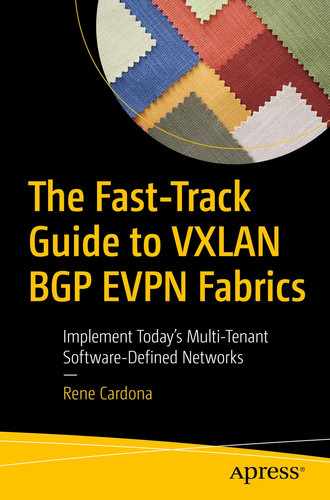Master the day-to-day administration and maintenance procedures for existing VXLAN fabrics. In this book you’ll discuss common issues and troubleshooting steps to help you keep your environment in stable operation. The Fast-Track Guide to VXLAN BGP EVPN Fabrics is a guide for network engineers and architects who can’t spend too much time learning everything about VXLAN. It has been created with the end goal of providing you with a straightforward approach to understand, implement, administer, and maintain VXLAN BGP EVPN-based data center networks. Using this book, you will understand Virtual Extensible LAN (VXLAN) as a technology that combines network virtualization and service provider class network attributes to solve the performance and scalability limitations in a three-tier design. You will learn to combine multiple links and provide equal-cost multipathing to effortlessly scale speed requirements without being worried about potential loops. You will learn VXLAN BGP EVPN configuration procedures with graphical step-by-step examples. You will be introduced to foundational concepts in VXLAN without the need to go over hundreds of documentation pages. This book is a clear and precise guide to implementing a spine and leaf architecture running with VXLAN. It explains how to perform day-to-day maintenance and administration tasks after implementing your first VXLAN fabric. It also explains how to integrate external devices such as firewalls, routers, and load balancers to VXLAN; how to leverage your VXLAN fabric; and how to create multiple tenant networks to secure your critical infrastructure. What You Will Learn Who This Book Is For Senior network engineers, solutions architects, and data center engineers.
Table of Contents
- Cover
- Front Matter
- 1. Introduction to Spine-and-Leaf Topologies
- 2. Logical Components of a VXLAN BGP EVPN Spine-and-Leaf Architecture
- 3. Encapsulating Layer 2 over Layer 3 with VXLAN
- 4. VXLAN Fabric Features and Functionalities
- 5. VXLAN Fabric to External Network Connectivity
- 6. VXLAN Fabric Topology Designs
- 7. VXLAN BGP EVPN Fabric Configuration Templates
- Back Matter
